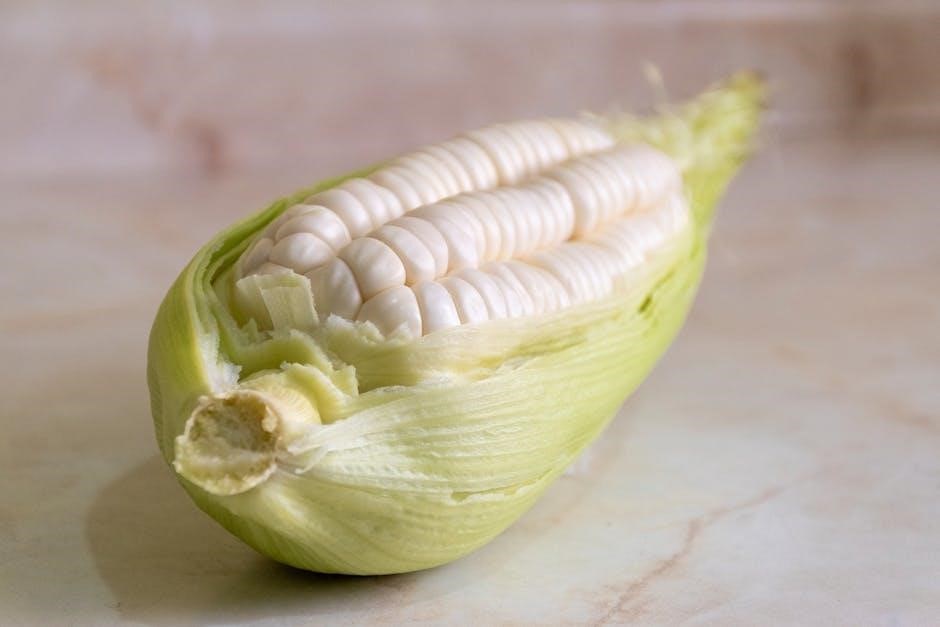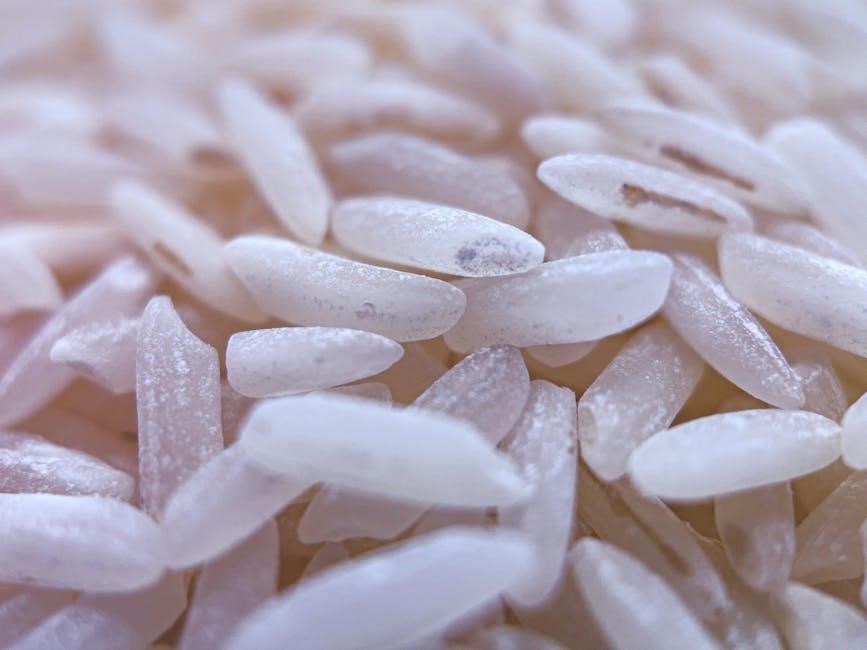Resistant starch is a carbohydrate that resists digestion, reaching the colon to act like dietary fiber, improving gut health, blood sugar regulation, and supporting weight management. Found in whole grains, legumes, and unripe fruits, it offers numerous health benefits, making it a valuable addition to a balanced diet.
Definition and Role in Nutrition
Resistant starch is a unique carbohydrate that resists digestion in the small intestine, functioning similarly to dietary fiber. It is categorized into four types, each varying in structure and resistance mechanisms. As a prebiotic, it ferments in the colon, supporting gut microbiota and enhancing nutrient absorption. Resistant starch plays a crucial role in overall nutrition by improving metabolic health, aiding in blood sugar regulation, and promoting satiety. Its ability to bypass digestion makes it a valuable component of a balanced diet, offering both nutritional and health benefits.
Importance of Resistant Starch in the Diet
Resistant starch serves as a prebiotic, fostering a healthy gut microbiome and enhancing nutrient absorption. It plays a key role in regulating blood sugar levels, improving insulin sensitivity, and supporting weight management by increasing satiety. Incorporating resistant starch into the diet promotes metabolic health and reduces the risk of chronic diseases. It is particularly beneficial for gut health, as it ferments in the colon, producing short-chain fatty acids that nourish intestinal cells. Thus, resistant starch is a vital component of a balanced and nutritious diet, offering both immediate and long-term health benefits.

Top Foods High in Resistant Starch
Beans, lentils, whole grains, unripe bananas, and cooked-and-cooled rice are among the top foods rich in resistant starch, offering significant health benefits when consumed regularly.
Legumes and Beans
Legumes and beans are excellent sources of resistant starch, with lentils, chickpeas, black beans, and kidney beans being particularly high. Lentils contain about 25.4% resistant starch, while chickpeas offer around 30%. These foods are rich in fiber and nutrients, making them a healthy choice. Cooking and cooling beans can further increase their resistant starch content, enhancing their digestive benefits. Incorporating legumes into meals supports gut health, blood sugar regulation, and weight management, making them a nutritious addition to a balanced diet.
Whole Grains
Whole grains are a rich source of resistant starch, with oats, barley, and pearl barley being notable examples. These grains contain naturally occurring resistant starch that supports digestive health. Barley, for instance, is particularly high in resistant starch, especially when consumed as pearl barley. Whole grains also provide essential nutrients like fiber, vitamins, and minerals. Incorporating whole grains into meals can enhance gut health, improve blood sugar levels, and contribute to overall well-being. They are a nutritious and versatile addition to a balanced diet.
Fruits High in Resistant Starch
Unripe bananas and plantains are among the richest fruit sources of resistant starch. Green bananas, in particular, contain a high proportion of resistant starch compared to ripe ones. Other fruits like green apples and pears also contribute, though in smaller amounts. These fruits provide a natural way to boost resistant starch intake, supporting gut health and blood sugar regulation. Incorporating unripe bananas and plantains into the diet is an effective way to reap the benefits of resistant starch from fruit sources.
Vegetables Rich in Resistant Starch
Raw potatoes and corn are excellent sources of resistant starch, particularly when uncooked or cooled after cooking. Jerusalem artichokes and underripe plantains also contribute significantly to resistant starch intake. These vegetables provide a natural way to incorporate resistant starch into meals, supporting digestive health and blood sugar balance. Cooking and cooling methods can enhance their resistant starch content, making them versatile additions to a diet focused on improving gut function and overall well-being.

How to Incorporate Resistant Starch into Your Diet
Incorporate resistant starch by adding whole foods like beans, lentils, and cooled rice or pasta to meals. Use cooking methods and portion practices to maximize benefits.
Cooking Methods to Maximize Resistant Starch
Cooking and cooling methods significantly enhance resistant starch content. Cooking rice or pasta and chilling it increases resistant starch due to starch retrogradation. Soaking beans and grains before cooking also boosts levels. High-amylose ingredients like corn and certain grains naturally retain more resistant starch during cooking. Avoid overcooking, as it breaks down starches. Incorporate cooked-and-cooled potatoes, rice, or pasta into meals for higher resistant starch intake. These methods ensure maximum retention and absorption of this beneficial nutrient.
Best Practices for Consuming Resistant Starch Foods
Incorporate resistant starch gradually to allow gut microbiota to adapt, reducing digestive discomfort. Start with small portions of high-resistant-starch foods like lentils or cooled rice. Pair these foods with fiber and protein to enhance nutrient absorption. Vary your food sources to ensure a diverse intake of resistant starch types. Avoid overconsumption, as excessive resistant starch can cause bloating. Listen to your body and adjust portions based on tolerance. Balancing intake ensures optimal benefits for gut health and overall well-being.

Health Benefits of Resistant Starch
Resistant starch promotes gut health, regulates blood sugar, aids weight management, and enhances immune function, acting like dietary fiber for overall well-being and better digestion;
Improving Gut Health
Resistant starch ferments in the colon, producing short-chain fatty acids like butyrate, which protect the gut lining and promote beneficial bacteria. This fermentation enhances colon health, improving digestion and reducing inflammation. It supports the growth of good bacteria, boosting the immune system and preventing harmful pathogens from colonizing. Regular consumption of resistant starch-rich foods can lead to a more diverse gut microbiome, improving overall digestive function and reducing the risk of gut-related disorders. It acts like dietary fiber, ensuring a healthy gut environment for optimal nutrient absorption and well-being.
Regulating Blood Sugar Levels
Resistant starch slows digestion, reducing rapid spikes in blood sugar levels. It fermented in the colon, producing acetate, which helps regulate glucose metabolism. Studies show resistant starch improves insulin sensitivity, benefiting both healthy individuals and those with diabetes. Foods like lentils, chickpeas, and cooled rice provide sustained carbohydrate release, preventing blood sugar fluctuations. Incorporating resistant starch into meals supports natural blood sugar control, enhancing metabolic health and reducing the risk of chronic conditions associated with poor glucose regulation. It offers a dietary approach to managing blood sugar effectively.
Supporting Weight Management
Resistant starch promotes weight management by increasing satiety and reducing appetite. It slows digestion, preventing rapid energy spikes and crashes, which helps maintain stable energy levels. Foods high in resistant starch, such as lentils and chickpeas, contribute to a feeling of fullness, making it easier to adhere to a calorie-controlled diet. Additionally, resistant starch improves metabolic efficiency and enhances fat oxidation, further supporting weight management. Incorporating resistant starch-rich foods into meals can aid in maintaining a healthy weight by balancing calorie intake and energy expenditure naturally.
Enhancing Immune Function
Resistant starch acts as a prebiotic, nourishing beneficial gut bacteria and fostering a balanced gut microbiome. This supports immune function by enhancing the gut’s barrier integrity and promoting the production of antibodies. Fermentation of resistant starch produces short-chain fatty acids, which reduce inflammation and strengthen immune responses. Incorporating foods like lentils, chickpeas, and cooled rice can enhance immune health naturally. A robust gut microbiome, supported by resistant starch, is essential for overall immune system efficiency and disease resistance.
Types of Resistant Starch
Resistant starch is categorized into four types: Type 1 (entrapped in whole grains), Type 2 (uncooked granules like raw potatoes), Type 3 (retrograded from cooked, cooled starch), and Type 4 (chemically modified for enhanced resistance). Each type varies in structure and origin, providing unique benefits and digestion patterns.
Type 1: Physically Entrapped Starch
Type 1 resistant starch refers to starches physically entrapped within whole plant cells, protecting them from digestion in the small intestine. Found in whole grains, legumes, and seeds, this type of starch remains intact due to the plant’s cell wall structure. Foods like barley, oats, and certain beans are rich in Type 1 resistant starch, which promotes gut health by reaching the colon undigested. This natural entrapment ensures it acts like dietary fiber, supporting beneficial gut bacteria and enhancing overall digestive well-being without being broken down into simple sugars.
Type 2: Granular Resistant Starch
Type 2 resistant starch consists of granules from certain plants, such as raw potatoes, green bananas, and plantains, which resist digestion due to their granular structure. Unlike Type 1, this type is not protected by cell walls but by the starch granules’ inherent properties. These granules remain intact in the small intestine because they are resistant to enzymatic breakdown. Found in uncooked or unripe foods, Type 2 starch is rich in amylose, a component that enhances its resistance. It is a popular dietary supplement, often extracted from cornstarch, and supports gut health and blood sugar regulation.
Type 3: Retrograded Starch
Type 3 resistant starch is formed when cooked starches, such as rice, pasta, or potatoes, are cooled, causing the starch molecules to recrystallize. This process creates a structure that resists enzymatic digestion in the small intestine. Retrograded starch is commonly found in cooked-and-cooled carbohydrate-rich foods, making it a significant source of dietary resistant starch. It is particularly abundant in foods like cooled rice, pasta, and potatoes, which are staples in many diets. This type of starch is easily incorporated into meals and offers a convenient way to boost resistant starch intake naturally.
Type 4: Chemically Modified Starch
Type 4 resistant starch is created through chemical modifications to enhance its resistance to digestion. This type is typically produced in laboratories to increase its stability and functionality. Chemically modified starches are often derived from natural sources like cornstarch and are designed to withstand harsh conditions such as high temperatures and acidic environments. They are widely used in food processing to improve texture and shelf life. This type of starch is less commonly found in whole foods but is added to certain processed products to boost their resistant starch content and nutritional value.
Factors Influencing Resistant Starch Content
Ripeness, cooking methods, processing, and storage conditions significantly influence resistant starch content, impacting its availability in various foods.
Ripeness and Cooking Methods
Ripeness and cooking methods significantly impact resistant starch content. Unripe foods like green bananas and plantains have higher resistant starch, as ripening converts starches into sugars. Cooking and cooling techniques, such as boiling potatoes or rice and then chilling them, can increase resistant starch by inducing retrogradation, where starches recrystallize and become more resistant to digestion. Conversely, overcooking or prolonged heat exposure can reduce resistant starch levels, highlighting the importance of optimal food preparation to maximize its benefits.
Processing and Storage Conditions
Processing and storage conditions significantly influence resistant starch content. Mechanical processing, such as grinding or milling, can disrupt starch granules, reducing resistance. Heat during manufacturing can also lower resistant starch levels. However, certain storage methods, like cooling or drying, can enhance resistant starch formation. For example, cooked foods high in starch, when cooled, undergo retrogradation, increasing resistant starch. Proper storage conditions, such as maintaining low moisture and moderate temperatures, help preserve resistant starch in foods like grains and legumes, ensuring their nutritional benefits remain intact for consumption.

Practical Tips for Increasing Resistant Starch Intake
Incorporate whole, unprocessed foods like legumes and whole grains. Cool cooked starches like rice or potatoes to boost resistant starch. Eat unripe fruits like bananas for higher RS content. Add raw potato starch to meals for an extra boost. Pair resistant starch foods with balanced meals for optimal benefits.
Adding Resistant Starch to Meals
Start by incorporating small portions of resistant starch-rich foods into your meals. Add cooked-and-cooled rice or pasta to salads for a fiber boost. Mix raw potato starch into smoothies or yogurt for an effortless addition. Use lentils or chickpeas as a base for soups or stir-fries. Sprinkle green banana flour into baked goods or oatmeal. Pair resistant starch foods with vegetables or lean proteins to balance your plate and enhance nutritional benefits.
Understanding Portion Sizes
Portion control is key when adding resistant starch to your diet. Start with small servings, such as 1/2 cup of cooked lentils or 1/4 cup of raw potato starch, to avoid digestive discomfort. Gradually increase portions as your body adapts. A typical serving size for resistant starch-rich foods like beans or whole grains ranges from 1/2 to 1 cup cooked. Be mindful of overall carbohydrate intake to maintain balance and prevent overconsumption of starches, ensuring a harmonious digestive and nutritional experience.
Common Foods with High Resistant Starch Content
Common foods high in resistant starch include lentils, chickpeas, cooled rice, and raw potatoes. These foods are excellent natural sources of resistant starch, supporting gut health.
Lentils and Chickpeas
Lentils and chickpeas are among the richest sources of resistant starch. About 25-30% of the starch in cooked lentils is resistant, while chickpeas contain 30-40% resistant starch. These legumes are versatile and nutrient-dense, making them ideal additions to meals. Cooking and cooling lentils and chickpeas can further enhance their resistant starch content, providing sustained energy and gut health benefits. Incorporating them into salads, soups, or as side dishes is a great way to boost your resistant starch intake naturally.
Cooled Rice and Pasta
Cooled rice and pasta are excellent sources of resistant starch, particularly when refrigerated after cooking. This cooling process increases their resistant starch content by allowing the starches to recrystallize, making them less digestible in the small intestine. Cooked and cooled rice can contain up to 1.6 grams of resistant starch per 100 grams, while pasta retains a significant portion of its starch during cooling. Including these foods in meals after cooling enhances their nutritional value and provides sustained energy and gut health benefits.
Raw Potatoes and Green Bananas
Raw potatoes and green bananas are rich in resistant starch, with raw potatoes containing up to 72% resistant starch. Green bananas also serve as a high source, as their unripe starches resist digestion. These foods bypass the small intestine, fermenting in the colon to support gut health. Consuming raw potatoes and green bananas can enhance digestive function and provide prebiotic benefits. They are ideal for incorporating resistant starch into meals, offering a natural and nutrient-dense option for improved overall health.
Digestive Issues and Resistant Starch
While resistant starch offers numerous health benefits, it can cause digestive issues in some individuals. High intake may lead to bloating, gas, and abdominal discomfort, particularly in those with sensitive digestive systems. This is due to its fermentation process in the colon, which can produce gas. However, these symptoms often subside as the gut microbiome adapts. To minimize discomfort, it’s recommended to gradually increase resistant starch intake and pair it with easily digestible foods. Proper cooking and portion control can also help mitigate potential digestive challenges.
Myths About Resistant Starch
Several myths surround resistant starch. One common myth is that it is completely undigestible, but some portions can be broken down. Another myth is that it is only found in specific foods, when in fact it is present in many, though in varying amounts. Additionally, some believe it is the same as dietary fiber, but they serve different roles. Understanding these misconceptions can help clarify the benefits and proper inclusion of resistant starch in a balanced diet, optimizing its potential health advantages effectively.
Resistant starch, a beneficial carbohydrate, enhances gut health, regulates blood sugar, and aids in weight management, making it a valuable addition to a healthy diet.
Final Thoughts on Resistant Starch Foods
Resistant starch is a powerful nutritional component offering significant health benefits, including improved gut health, blood sugar regulation, and weight management. Incorporating resistant starch-rich foods like beans, lentils, whole grains, and unripe fruits into meals can enhance overall well-being. While resistant starch provides numerous advantages, it is most effective as part of a balanced diet. By understanding its benefits and sources, individuals can make informed choices to optimize their nutrition and support long-term health goals.
References
“Critical Reviews in Biotechnology” (2016) ─ Study on resistant starch definition and its role in nutrition.
University of Illinois ─ Research on lentils and their high resistant starch content.
“Foods High in Resistant Starch” ─ List of top resistant starch foods and their benefits.
AOAC ─ Standardized methods for measuring resistant starch content in foods.
“Health Benefits of Resistant Starch” ⎻ Insights into gut health and blood sugar regulation.
“Journal of Nutrition” ⎻ Studies on resistant starch and weight management.
“Digestive Health” ⎻ Guidance on incorporating resistant starch into daily diets.
